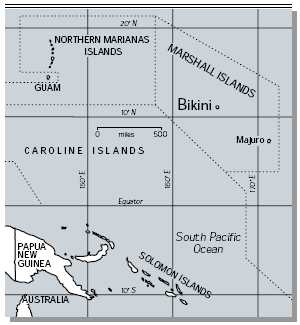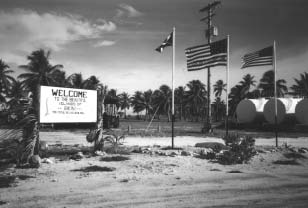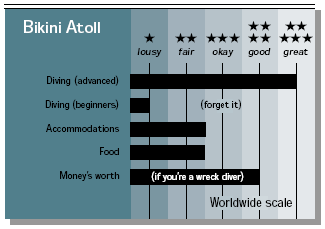Post-Nuclear Diving at Bikini AtollContents of this Issue: Post-Nuclear Diving at Bikini Atoll The Lump in My Shorts: How to Rescue Film Editorial Office: Ben Davison Publisher and Editor Undercurrent 3020 Bridgeway, Suite 102 Sausalito, CA 94965 The sand crabs are hot, but the fish life’s not from the January, 1997 issue of Undercurrent
Dear Fellow Diver, I puff a breath of air into my BC and hover five feet off the flight deck of the U.S.S. Saratoga, 100 feet down in Bikini Lagoon. The visibility is 80 feet. I look to my right across the expanse of the flight deck and it smears into blue haze; looking left, it's the same thing -- no end in sight. I don't bother looking fore and aft, since she's 880 feet long. During World War II, the Japanese claimed on seven different occasions to have sunk "Sara." The reality is less honorable: her own country sank her in 1946, in a nuclear holocaust called Operation Crossroads.
Deeper into the wreck at the hangar-deck level, I see 500- pound bombs, racks of rockets, stacks of torpedoes. A couple of fighter planes, Thunderbolts, sit broken in the silt. Behind them, an Avenger, like the one George Bush flew, looms out of the murk. But the United States Navy is not the only giant broken in these waters. Our next dive is on the Nagato. From the bridge of this massive battleship, Admiral Yamamoto launched the aerial attack on Pearl Harbor. The next tomb I visit is that of the U.S.S. Pilotfish, which was in Tokyo Bay at the surrender ceremonies. Then on to the U.S.S. Carlisle, the destroyer that searched for weeks for Amelia Earhart. And on I go, through six incredible days of wreck diving. I am one of fewer than 50 people to have dived these wrecks since they were driven to the bottom by manmade winds of up to 43,000 miles per hour. After years of radiation monitoring and long months of negotiation, the historic shipwrecks of Bikini Atoll are finally being opened up to recreational divers. The monitoring was done, and is still being done, by the U.S. Department of Energy to ensure that radiation levels in the lagoon are low enough to permit safe diving. They are, says DOE; you'll get a higher dosage hanging around Los Angeles. Meanwhile, scores of eager dive packagers from all over the world negotiated for months with the Bikini government for rights to the diving. The winner: Marshall Islands Dive Adventures. Getting to Ground Zero
Getting there ain't half the fun; as a matter of fact, it's not any of the fun. From the continental 48, you go to Honolulu. After a night in Honolulu, you catch a weekly 8:30 a.m. flight to the island of Majuro. You spend the night in Majuro, then catch an 8:00 a.m. plane to Enue, which is part of the Bikini Atoll. You are greeted by staff at Enue. You take a 50-minute boat ride to Bikini proper, then a five-minute truck ride to your quarters. Fifteen time zones and one International Date Line later, I was glad to settle in. The island is typical atoll geography -- highest point about three feet above mean sea level. It's planted beach to beach with coconut trees. Between the coconut trees grow scrubby palmettos and a few weeds; no streams, rivers , ponds, or lakes. All roads are dirt; a few trails cut through the groves. The rooms are spartan but clean and air conditioned, with
hot and cold running water and 110-volt, 60-cycle electric
service. A small ice chest is provided to keep a couple of
cold drinks at your fingertips. A few yards away is "Ground
Zero," the main dining hall/kitchen/library/B.S. Central.
Coffee is available at 6:30, breakfast at 7:30. Because of
radiation concerns, nothing that has been grown on the island
is eaten; everything is brought in (read: canned, packaged,
frozen, or condensed). But if you think you can put a dent in
your love handles while you're there, forget it. Eggs, bacon,
sausage, pancakes, French toast, cereal, juice, and toast are
provided every morning. Lunch, at 12:30, ranges from cold cuts
to hot casseroles. About a hundred yards from Ground Zero is the company store, run by the DOE, where you can spend your money on cold soft drinks and beer, Tshirts, hats, bumper stickers, and a rather eclectic variety of other dry goods. Need a 100-pound bag of rice? A package of carbon paper? Sanitary napkins? An onion? A mummified Snickers bar? Prices are 20 percent higher than in Majuro. Prices in Majuro are 30 percent higher than in Honolulu. Prices in Honolulu are 20 percent higher than on the mainland. I was able to resist buying that pack of carbon paper (ten sheets for $13), so unless there's been an influx of careless journalists, it's still there for you.
Right up the road from the store is a DOE entertainment complex, open any time you get the urge, with a large selection of videotapes and a big-screen TV as well as pool and Ping-Pong tables. Not much else to do here. With only three Americans and one Brit as paying customers, we sat around in the evenings and told lies about previous dives, and between lies we went to the screening room and watched dirty pictures of naked fish and unclothed wrecks. I covered the entire island
on foot, since jet lag had me
up early every morning.
High Tech for Low Down Briefings began as soon as we were met at the airport. After checking into my room, I grabbed my gear and headed for a dive. The dive shop is next to the living quarters. All equipment is brand new. The regulators and BCs are Scubapro, the tanks are lowpressure OMS, and the two compressors are Bauer; we're talking top of the line. I used twin OMS 85s with a DiveRite isolation manifold all week. Other divers used singles some days and doubles on others. The tank fittings are DIN, with a screw-in adapter to accommodate regular sport-diving first stages. If you want to carry a stage or pony bottle instead of strapping on a pair of doubles, there's a whole corral full of ponies all set up with clips. Just tell 'em what you like to dive with and they'll configure it for you. On the checkout dive I wasn't expected to perform any skills. They just checked me out on a 100-footer, with no planned deco. My C-card was examined, as was my logbook. The dive boat, Bravo, is a 40-foot, twin-diesel vessel that makes an ideal platform. The staging/storage area is completely covered to protect you from the tropical sun. Tanks are stored outboard, and there's plenty of room for your gear beneath the seats. A two-tiered camera table is provided. The boat looks like she could handle 12 divers, but we were only three. The dive platform is nice and wide, and a pair of dive ladders make for easy reentry. If you like, you can slip out of your tanks and BC in the water and the boat crew will lift them into the boat and put them away for you. If you're wearing doubles, this is a nice touch. At least two divemasters always dive with you. Both provide guide service if asked; if not, they hang around and keep an eye on you. But you dive as deep as you wish, for as long as you wish. One divemaster carries an extra tank of air (80 cf) with two regs. Just Hanging Around
Each wreck has a permanent mooring buoy attached to it. Once the boat is tied off, a set of twin-level decompression bars is lowered into the water. One bar sits at 20 feet, the other at 10. Pure oxygen is dropped over the side, with regulators available for those riding out their decompression obligations. In addition, there is a DAN O2 kit on board. The routine is two dives per day, one in the morning, one in the afternoon. Now, before you start shaking your head in disgust, let me describe the dive environment. Envision a 200- foot-deep hot tub; no current, no surge, no thermoclines, waves topside rarely taller than two feet, 86 ° water at the surface plummeting to 84° at 190 feet. Everything is deep. My average dive was 150 feet; but unlike Truk and some other places, there are no 30-foot dives available. All but two of my dives were planned decompression dives. Run times of well over an hour were not uncommon; my longest exposure was 92 minutes, and I had several that were 70 to 80 minutes. It's quite easy to build up an alarming amount of residual nitrogen that your slow tissue groups never quite shake. My computers never slept the entire time I was there. Surface intervals of four hours were used to motor back to the dock, get the tanks recharged, and grab some lunch. Out again by 2:00 p.m., back at the dock by 5:30 or 6:00. My dive days were filled up. One day I did squeeze in three dives, but it made for a long day, and one of my computers was trying to call DAN by the end of the third dive to report my imminent case of DCI. You're a long, long way from a recompression chamber. There's one in Kwajalein, but it's owned and operated by the U.S. Army. The feeling was that if you were twisted enough, and if the chamber were unoccupied, the Army might fit you in. To even get your bent body to Kwaj, arrangements would have to be made for a charter air lift, and you can't just pick up the phone and call 911 from here. Chamber help is, at a minimum, 24 hours away. And if Kwaj is busy or won't take you, the next stop is Honolulu. This is not the place to push the limits.
If You're Not into Wreck Diving . . .
Those deep dives and long hang times are worth it if you're into wrecks, history, and science. But that's a big IF. Sea life is not an attraction here. The bottom of the lagoon is like Truk -- basically a sandy bowl. Unlike Truk, however, because of the radioactive material from our nuclear testing I can only assume that this area was essentially a sterile petri dish for several years after. Coral growth and general encrustation is more like on wrecks off Florida that have been down ten years -- soft corals just beginning, no sponges, tiny sea fans. Around the wrecks are small schools of fish, a few large groupers in the recesses. There's whitetips and blacktips in profusion, but compared to other Pacific locales, this place is dead. Shore diving is not worth the effort; I scooted around on a couple of reefs with a DPV and found nothing of interest (they have two DPVs that they'll rent out, at $10 per dive, but they're primarily for use by the staff for the exploration work they're still doing on the wrecks). But if it's wrecks you want to dive, it's a dynamite trip -- no, an atomic trip. These wrecks are in excellent shape. The lack of encrustation is actually a plus, because you can see what the ships really look like. You can tell that the pod of guns on the starboard side of the Saratoga really are the 40-mm antiaircraft weapons that protected her from kamikaze attacks. If You Still Want to Go, Be Prepared . . .
This trip is obviously not for anyone but a trained, experienced, deep-air diver. If you get the chokes when your computer tells you you've gone into the deco mode, or if 40-minute decompression sessions drive you nuts, this place will hold no appeal for you. If it does interest you, get some experience diving doubles and managing two different gas supplies. Bring a doubles rig and at least two dive computers with you. For peeking into holes and doing some penetration, bring a couple of lights and at least one reel. Get your antisilting finning technique down to a fine science. Visit your doctor and your dentist to make sure all your personal systems are sound; there's no medical help. There's also no telephones and no TV. All communication with the outside world is via VHF radio to Enue, relayed to Majuro, then to the continent.D o not bring non-diving persons who require entertainment. They will expire from boredom in two days, and the price is the same whether you dive or not. I give Bikini and Marshall Islands Dive Adventures two enthusiastic thumbs up. This is a "gotta go there" place, and it will get better over time. The logistical problems they face are enormous, but they're doing it right, and doing all the right things. By the beginning of the '97 dive season (April-November), they plan on pumping trimix and nitrox. The trimix will give you a clear head at depth; the custom nitrox will help reduce your total run times; and the pure O 2 at 20 to 10 feet will help scrub that nitrogen out of the old tissues. J. M. |

I want to get all the stories! Tell me how I can become an Undercurrent Online Member and get online access to all the articles of Undercurrent as well as thousands of first hand reports on dive operations world-wide
| Home | Online Members Area | My Account |
Login
|
Join
|
| Travel Index |
Dive Resort & Liveaboard Reviews
|
Featured Reports
|
Recent
Issues
|
Back Issues
|
|
Dive Gear
Index
|
Health/Safety Index
|
Environment & Misc.
Index
|
Seasonal Planner
|
Blogs
|
Free Articles
|
Book Picks
|
News
|
|
Special Offers
|
RSS
|
FAQ
|
About Us
|
Contact Us
|
Links
|
3020 Bridgeway, Ste 102, Sausalito, Ca 94965
All rights reserved.


 Dinner, around 7:00, can be pork chops,
chicken, fish, Italian food, or Mexican food, always followed by some obscenely rich dessert.
Lemonade, fruit juice,
and water (tested regularly by
Livermore Labs for safety) are
available 24 hours a day.
Their ability to handle special
dietary requirements is
very limited, so consider your
needs carefully. Vegetarians
can survive, but low-salt or
low-sugar diets can't be accommodated.
Dinner, around 7:00, can be pork chops,
chicken, fish, Italian food, or Mexican food, always followed by some obscenely rich dessert.
Lemonade, fruit juice,
and water (tested regularly by
Livermore Labs for safety) are
available 24 hours a day.
Their ability to handle special
dietary requirements is
very limited, so consider your
needs carefully. Vegetarians
can survive, but low-salt or
low-sugar diets can't be accommodated. There's very little bird life
or animal life in the interior.
I found the silence
rather spooky at first.
There's very little bird life
or animal life in the interior.
I found the silence
rather spooky at first. 